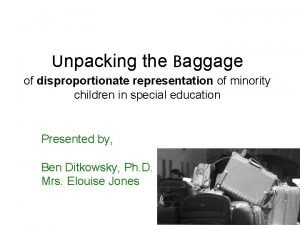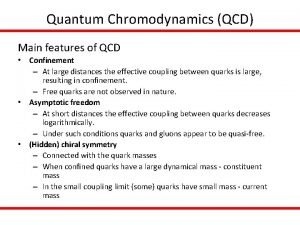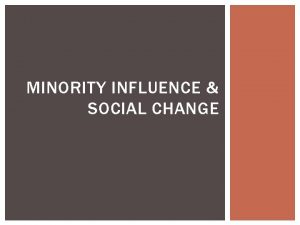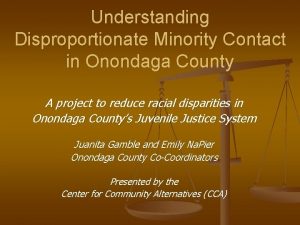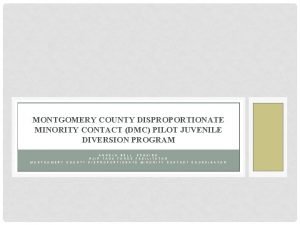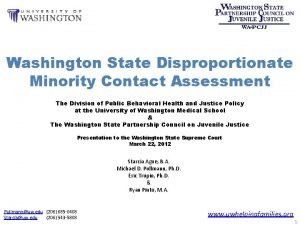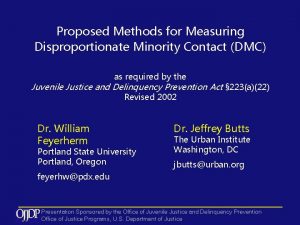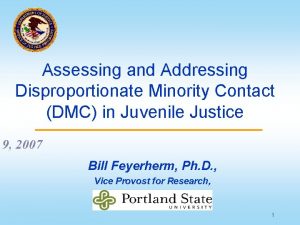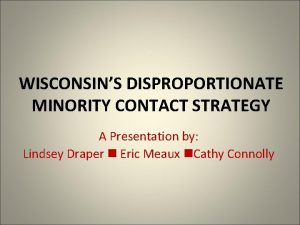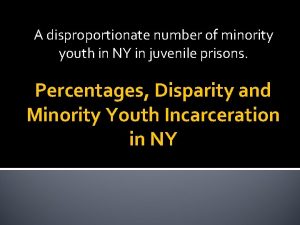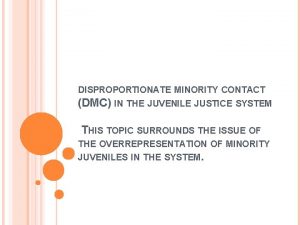Disproportionate Minority Confinement Class 7 Disproportionate Minority Confinement











- Slides: 11

Disproportionate Minority Confinement Class 7

Disproportionate Minority Confinement (DMC) • What is DMC? – Under the Juvenile Justice and Delinquency Prevention Act (JJDPA), DMC exists when the proportion of youths detained or confined in detention facilities who are members of minority groups exceed their groups' proportions in the general population. • How widespread is the problem? – Nationwide, at virtually every stage of the juvenile justice process, minority youth are overrepresented relative to population, and in many cases, relative to offending rates. – Minority youths received disparate decisions, particularly with regard to incarceration.

History of DMC • DMC was brought to national attention by the Coalition for Juvenile Justice (formerly the National Coalition of State Juvenile Justice Advisory Groups) in its 1988 annual report to Congress, A Delicate Balance. • In the 1988 Amendments to the Juvenile Justice and Delinquency Prevention (JJDP) Act of 1974, Congress required that States address DMC in their State plans. • In the 1992 Amendments to the JJDP Act, DMC was elevated to a core requirement, with future funding eligibility (25 percent of the States' JJDP Formula Grants allocations) tied to State compliance. Each year, OJJDP reviews States' 3 - year comprehensive JJDP plans and plan updates to determine States' compliance with the DMC core requirement. (Source: Office of Juvenile Justice and Delinquency Program)

Facts About DMC • Although minority youth are one-third of the adolescent population, they represent approximately two-thirds of the youth confined in local detention and state correctional systems. • While representing 34% of the U. S. population, minority youth represent: – 62% of youth in detention – 67% of youth committed to public facilities – 55% of youth committed to private facilities • In 1997, three out of four juveniles admitted to state prisons were minority youth. (Source: And Justice For Some, 2000, Building Blocks For Youth)

Incarceration Disparities • Human Rights Watch Report (2002) (http: //hrw. org/english/docs/2002/02/27/usdom 3768. htm) – In six states, black youth under age eighteen are incarcerated in adult facilities at rates between twelve and twenty-five times greater than those of white youth – Hispanic youth are incarcerated at rates seven to seventeen times greater than those of whites in Connecticut, Hawaii, Massachusetts, and New Hampshire, while the incarceration rate for black youth is between twelve and twenty-five times greater than those of whites in Connecticut, Delaware, Iowa, Massachusetts, Montana, and New Jersey.

Is it Race or Neighborhood?

DMC In NYC • New York minority youth population: 41% • In 1997, minority youth accounted for 87% of commitments to public facilities and 81% of detention placements. • In NYC, blacks and Hispanics were held in secure detention following their initial appearance in court 1. 4 times as often as whites. • A national study of the transfer of youth to adult criminal courts showed that prosecutors in NYC filed 94% or more cases in adult courts involving minority youth.

Why Are Minority Youth Disproportionately Detained? • While white youth and minority youth commit several categories of crime at the same rate, minority youth are more likely to be arrested – Drug crimes – More visible crimes ? – Discretionary deployment of police resources – Disparate application of police discretion – Social science evidence: • Geoffrey Alpert – Criminology – police formation of suspicion • Robert Sampson and Steven Raudenbush – racial differences in perceptions of disorder • Sandra Graham – Law & Human Behavior – police stereotyping (priming) • People involved in the decision to detain a juvenile offender may be influenced by stereotypes – Social science evidence: • George Bridges and Sarah Steen – Amer. Soc. Rev. – race and probation decisions • White youth generally have access: – better legal representation – better programs and services to fashion alternatives to incarceration

Key Social Science Evidence • George S. Bridges & Sara Steen, “Racial Disparities in Official Assessments of Juvenile Offenders: Attributional Stereotypes as Mediating Mechanisms of Juvenile Offenders, ” 63 American Sociological Review, 554(1998) • Jeffrey Fagan, & Garth Davies, “Street Stops and Broken Windows: Terry, Race and Disorder in New York City, ” 28 Fordham Urban Law Journal 457 (2000). • Sandra Graham & B. Lowery, “Priming Unconscious Racial Stereotypes about Adolescent Offenders, 28 Law and Human Behavior 483 (2004). • Geoffrey P. Alpert, John P. Mac. Donald, & Roger G. Dunham, “Police Suspicion and Discretionary Decision Making During Citizen Stops, ” 43 Criminology 407 (2005).

The Meaning of DMC Has Changed In 2002, the JJDP Act modified the DMC requirement: No longer disproportionate confinement, but disproportionate contact with the juvenile justice system • Contact includes: – Arrest – Diversion – Referral to juvenile court – Adjudication as delinquent – Placement on probation – Transfer to adult court

Leverage Points for Regulation and Change • Most of the impact of race occurs at the front end… arrest, initial disposition of arrest, and most important, detention • Detention outcome is strongest predictor of case outcome and sentencing • Impact of detention on future crime, work, marriage (longitudinal studies) – mortgaging effects • There is less disparity in later stages of criminal justice processing by race – Sentencing – Waiver to criminal court • Sentencing structures reify police discretion
 Jenis jenis sampel
Jenis jenis sampel What causes dwarfism in humans
What causes dwarfism in humans Pase vs hannon
Pase vs hannon Confinement qcd
Confinement qcd Solitary confinement effects
Solitary confinement effects Thomas silverstein art
Thomas silverstein art Inertial confinement
Inertial confinement Exemple de projet d' enseignement scientifique
Exemple de projet d' enseignement scientifique Inertial confinement
Inertial confinement Inertial confinement fusion lasers
Inertial confinement fusion lasers Confinement principle in computer system security
Confinement principle in computer system security Behaviours that enable a minority to influence a majority
Behaviours that enable a minority to influence a majority


